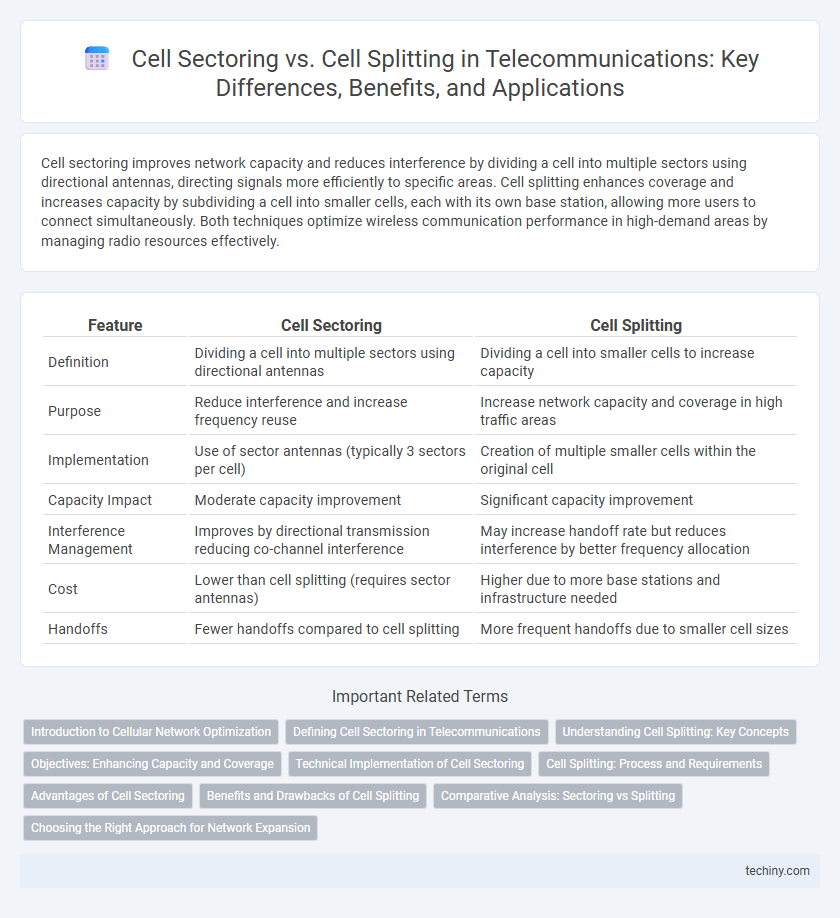Cell sectoring improves network capacity and reduces interference by dividing a cell into multiple sectors using directional antennas, directing signals more efficiently to specific areas. Cell splitting enhances coverage and increases capacity by subdividing a cell into smaller cells, each with its own base station, allowing more users to connect simultaneously. Both techniques optimize wireless communication performance in high-demand areas by managing radio resources effectively.
Table of Comparison
| Feature | Cell Sectoring | Cell Splitting |
|---|---|---|
| Definition | Dividing a cell into multiple sectors using directional antennas | Dividing a cell into smaller cells to increase capacity |
| Purpose | Reduce interference and increase frequency reuse | Increase network capacity and coverage in high traffic areas |
| Implementation | Use of sector antennas (typically 3 sectors per cell) | Creation of multiple smaller cells within the original cell |
| Capacity Impact | Moderate capacity improvement | Significant capacity improvement |
| Interference Management | Improves by directional transmission reducing co-channel interference | May increase handoff rate but reduces interference by better frequency allocation |
| Cost | Lower than cell splitting (requires sector antennas) | Higher due to more base stations and infrastructure needed |
| Handoffs | Fewer handoffs compared to cell splitting | More frequent handoffs due to smaller cell sizes |
Introduction to Cellular Network Optimization
Cell sectoring enhances cellular network optimization by dividing a single cell into multiple sectors, typically using directional antennas to reduce interference and increase capacity without requiring additional frequencies. Cell splitting involves subdividing a larger cell into smaller cells, each with its own base station, to improve coverage and support higher user density by reusing frequencies more efficiently. Both techniques are fundamental in managing spectrum resources and improving overall network performance in dense urban environments.
Defining Cell Sectoring in Telecommunications
Cell sectoring in telecommunications refers to dividing a cell area into multiple sectors, each served by its own directional antenna to improve capacity and reduce interference. This method enhances frequency reuse by isolating signals within specific sectors, optimizing coverage and network efficiency. Compared to cell splitting, sectoring maintains the same cell size while boosting performance through antenna orientation and power control.
Understanding Cell Splitting: Key Concepts
Cell splitting involves dividing a congested cell into smaller cells with reduced coverage areas, increasing frequency reuse and network capacity. This technique improves signal quality and supports higher user density by deploying additional base stations within the original cell boundaries. Effective cell splitting requires careful frequency planning and power control to minimize interference between adjacent smaller cells.
Objectives: Enhancing Capacity and Coverage
Cell sectoring enhances capacity and coverage by dividing a cell into multiple sectors, each served by a directional antenna, reducing interference and increasing frequency reuse efficiency. Cell splitting increases network capacity by subdividing a cell into smaller cells with lower power base stations, allowing more simultaneous users within the same geographic area. Both techniques are essential for optimizing frequency spectrum utilization and improving quality of service in cellular networks.
Technical Implementation of Cell Sectoring
Cell sectoring involves dividing a cell into multiple sectors using directional antennas, typically three or six, to improve capacity and reduce interference by isolating signals within each sector. Technical implementation requires installing sector antennas with distinct beam patterns on existing cell towers, along with selective frequency reuse and advanced antenna configurations to enhance signal quality. This approach effectively increases network throughput and minimizes call drops while optimizing radio resource allocation in dense urban environments.
Cell Splitting: Process and Requirements
Cell splitting involves dividing a congested cell into smaller cells with individual base stations, enhancing capacity and coverage in high-traffic areas. This process requires careful frequency planning, upgraded infrastructure, and efficient handoff management to minimize interference and maintain service quality. Implementing cell splitting improves spectral efficiency and supports increasing user density in wireless networks.
Advantages of Cell Sectoring
Cell sectoring enhances network capacity by dividing a cell into multiple sectors, allowing frequency reuse within the same coverage area and reducing co-channel interference. It improves signal quality and system performance through directional antennas that focus energy toward specific sectors. This targeted approach leads to increased data rates and better coverage without the need for additional cell sites, making it a cost-effective solution for network expansion.
Benefits and Drawbacks of Cell Splitting
Cell splitting increases network capacity by dividing a congested cell into smaller cells, each with its own base station, which reduces interference and allows more simultaneous users. The benefits include improved frequency reuse and enhanced coverage in high-demand areas, but drawbacks involve higher infrastructure costs and increased complexity in handoff management between cells. This method is best suited for densely populated urban environments where demand scalability outweighs the additional operational challenges.
Comparative Analysis: Sectoring vs Splitting
Cell sectoring enhances capacity and reduces interference by dividing a cell into multiple sectors, each served by directional antennas, enabling focused coverage and better frequency reuse efficiency. Cell splitting increases network capacity by reducing the cell size and deploying additional base stations, which improves signal quality but requires significant infrastructure investment. While sectoring offers a cost-effective means to optimize spectral efficiency within existing cells, splitting delivers finer capacity scaling at the expense of higher deployment complexity and operational costs.
Choosing the Right Approach for Network Expansion
Cell sectoring enhances coverage by dividing a cell into smaller sectors using directional antennas, which increases capacity and reduces interference without additional frequency requirements. Cell splitting involves subdividing a cell into smaller cells, each with its own frequency allocation, effectively increasing capacity but requiring more spectrum and infrastructure. Choosing the right approach depends on available frequency resources, cost considerations, and specific capacity demands in the network expansion area.
Cell Sectoring vs Cell Splitting Infographic

 techiny.com
techiny.com